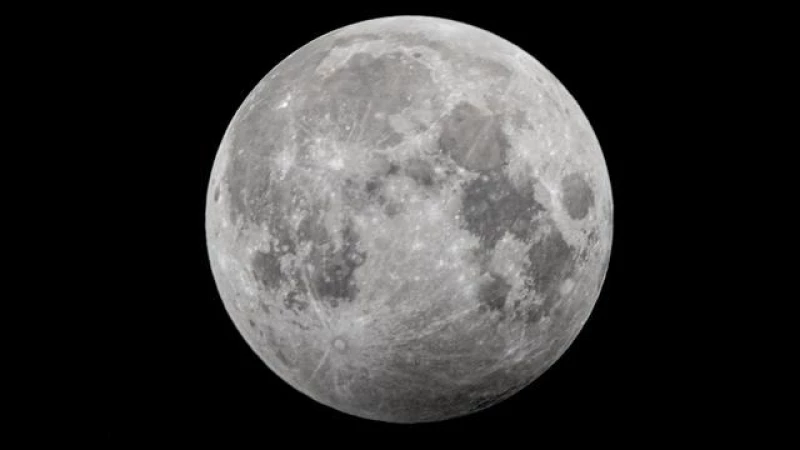Plants and animals are dying off at an unprecedented rate on Earth. Some scientists are looking to outer space for a solution.
The idea is called a lunar biorepository, a facility that maintains and stores plant and animal cells. But instead of on Earth, this would be on the moon.
Why the moon?
"There's no place on Earth cold enough to do it," explained Mary Hagedorn, a senior research scientist with the Smithsonian National Zoo and Conservation Biology Institute.
Hagedorn has spent the last two decades studying and theorizing modern ways to try and save coral reefs. She is an expert in cryopreservation, the process of freezing biological materials like animal cells at a temperature so cold, it allows them to remain frozen but alive for hundreds of years.
"Let's imagine that, unfortunately, climate change wiped out 90% of the Great Barrier Reef. Well, in 100 years, we might be able to just give them back all that diversity," Hagedorn said.
Her inspiration is the Arctic Svalbard Seed Vault in Norway It is a biorepository that keeps seeds at just under 0 degrees Fahrenheit due to the natural temperature of the permafrost. The low temperature and moisture levels in the vault keep the seeds viable for long periods of time.
"Svalbard has done a really great job of saying, 'OK, we need to preserve seeds. Everything on Earth depends on seeds. And how are we going to do that?'" Hagedorn said.
Hagedorn and her team want to do something similar for animal cells, but they need colder temperatures. At the lunar poles, where deep craters are shaded, temperatures reach as low as minus 320 degrees Fahrenheit or colder.
Preserving these animal skin cells, called fibroblast cells, allows scientists to transform them into sex cells, which is how they clone animals in labs.
In addition to threatened and endangered animals like the African elephant, green sea turtle and great cats, the team at the Smithsonian Institute proposes that the lunar biorepository initially include an array of animal species that serve different purposes, including:
- Organisms that modify their environment, like coral, beavers, woodpeckers, and earthworms.
- Pollinators that support the production of food, like bees, moths, and bats.
- Animals that live in extremely warm, cold, or acidic environments, like monarch butterflies, polar bears, and nematodes.
- Organisms that support the web of life on Earth, like zooplankton, boreal trees, and mosses.
Cryopreserved human cardiac stem cells have also recently been sent to the International Space Station.
Challenges in space
As a trial, the Smithsonian Institute collected 10 specimens of the Starry Goby, a fish found in Kane`ohe Bay in Hawaii. The vision is that these cells will be sealed into cryo-packaging and tested under space-like conditions on Earth, followed by a test run on the space station.
How the Smithsonian plans to create cryopreserved cells and test them in space:
Teams at the National Science Foundation's National Ecological Observatory Network are also collecting nearly 100,000 animal cell samples every year from 81 sites. NEON's goal is to expand the kinds of cells used in cryopreservation to include sperm and oocytes, which are found in ovaries.
While a lunar biorepository may be a promising idea for preserving Earth's biodiversity, there are challenges for this program.
Researchers said one of the most difficult problems posed by a lunar biorepository would be the radiation exposure to samples. Countermeasures to radiation could include antioxidant cocktails, as well as providing physical barriers like water, lead, or cement to block radiation.
Temperatures on the moon's surface, which make freezing possible, are also a concern.
Certain areas of the moon can reach more than 200 degrees Fahrenheit during the lunar day, which is equivalent to about 14 days on Earth. The much colder temperatures in the craters of the North and South Poles, could make it difficult to transport biomaterials.
Another challenge is that those areas, known as "permanently shadowed regions," are believed to have large amounts of ice, conditions that would make human monitoring extremely difficult.
The long-term effects of microgravity on cells could also pose a problem.
Some say seeking a solution on the moon shouldn't be the No. 1 priority.
"I don't think it's right idea for right now," Noah Greenwald, the endangered species director at the Center for Biological Diversity, said.
"I think we really need to focus on protecting more of the natural world, so we don't lose species in the first place," he said.
A decades-long effort
Hagedorn isn't the only scientist working to create a biorepository on the moon.
In 2021, University of Arizona researchers proposed a concept to send an ark filled with 335 million sperm and egg samples to the moon.
"They're engineers," Hagedorn noted. "So, we're more biologists coming at this. We know how to cryopreserve. We started the sample. But they have a great sense of how to use robots."
In a statement, Hagedorn emphasized that the establishment of a lunar biorepository is a project that has been in the works for decades. He highlighted the need for collaboration among various nations, agencies, cultural groups, and other stakeholders to make this vision a reality.
Greenwald drew attention to the urgency of the extinction crisis, noting that while climate change is receiving the necessary focus, the extinction crisis is equally critical. He emphasized the essential role of species in maintaining ecosystems and highlighted their contributions to air and water quality, climate regulation, and nutrient cycling.
"Species serve as the foundation of ecosystems. They play a crucial role in purifying our air and water, regulating our climate, and recycling nutrients. The rapid loss of species indicates a significant decline in the ecosystems that are vital for our own survival," Greenwald stated.







